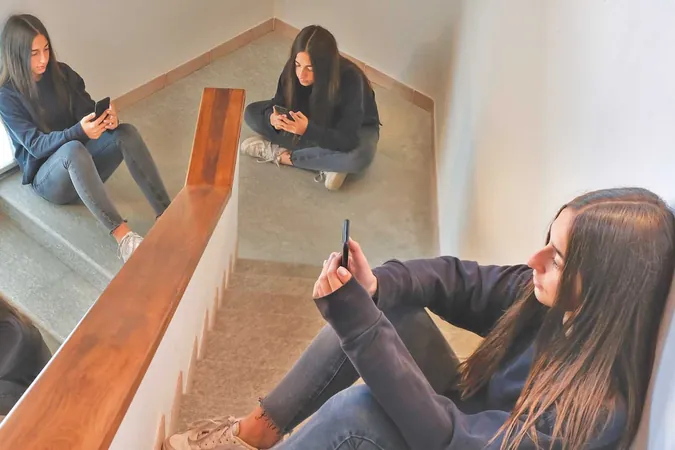
Mental Health Awareness Among Youth Soars as Crisis Deepens in Nepal: A Call to Action!
2025-01-10
Author: Rajesh
Introduction
As mental health issues increasingly afflict adolescents in Nepal, a growing movement is taking shape among the youth to confront these challenges openly. According to the National Mental Health Survey of Nepal from 2020, approximately 5.2% of adolescents were reported to suffer from mental disorders, with neurotic and stress-related conditions affecting 2.8%. Alarmingly, the prevalence of suicidal thoughts among young people was around 4%, and the suicide attempt rate was 0.7%.
Current Situation
Fast forward to 2023, and the situation appears dire. Data obtained from Nepal Police indicates that 7,223 people tragically took their own lives during the fiscal year of 2023-24, following a total of 13,823 suicides across 2021 and 2022. Particularly concerning is the fact that over 40% of these victims were farmers, while students constituted the second-largest demographic, accounting for 15.4%.
Changing Attitudes
Despite these alarming statistics, mental health professionals are observing a significant shift among younger individuals. Dr. Rishav Koirala, a leading psychiatrist and director of the Brain and Neuroscience Center, states that the past decade has led to a generational change in attitudes toward mental health. Today’s youth, particularly those between 23 and 30 years old, grew up during a time when mental health discussions began to gain momentum on social media, and the COVID-19 pandemic further underscored the urgency of addressing mental health concerns.
Influence of Celebrities
High-profile celebrities in both Hollywood and Bollywood have also contributed to the conversation by openly discussing their mental health struggles, thus normalizing the narrative around issues such as depression and bipolar disorder. Dr. Koirala notes that while a decade ago, mental health issues were often brushed aside, today’s youth are more proactive in seeking help, even for what may appear to be minor concerns.
Youth Seeking Help
"There is a remarkable trend where even young individuals without severe mental disorders are approaching us for consultations," Koirala adds. "Their willingness to engage with mental health professionals is promising."
Concerns Raised by Counselors
Counselor Ruban Dahal echoes this sentiment, noting that youth preparing for international opportunities often express a desire to address their mental health before leaving the country, a significant shift from prior generations. However, Dahal warns of escalating challenges youth face today, including increased feelings of loneliness and anxiety, largely exacerbated by fierce job competition and economic instability.
Social Media's Paradox
The rise of social media platforms has not only transformed how young people connect but has also paradoxically led to feelings of isolation. As youth spend more time on platforms like Instagram, the pressure to showcase a curated, enviable life exacerbates feelings of inadequacy. Dahal highlights that technology, intended for connection, is leading to disconnection across communities.
Emerging Mental Health Challenges
One alarming trend observed by Dr. Koirala is the rising acknowledgment of adult ADHD (Attention Deficit Hyperactivity Disorder) and various personality disorders among youths. Historically thought to predominantly affect children, ADHD has emerged as a significant concern in adults over the past few years, with Koirala treating an average of 20 cases related to adult ADHD monthly.
Misunderstanding Mental Health Terminology
Furthermore, the use of mental health terminology has become increasingly casual among the youth, leading to misunderstandings and unhealthy self-labelling. Research indicates a troubling trend, with 48% of youths self-diagnosing anxiety and 37% self-identifying as depressed.
Hope Despite Challenges
Despite these disconcerting developments, there is hope. Experts affirm that young individuals are beginning to recognize that effective mental health treatment encompasses more than just medication; lifestyle changes and psychotherapy play critical roles. There is a growing acceptance of various treatment modalities, and many youths are now advocating for mental health services for their friends and family members.
Disparities in Access to Care
While urban areas like Kathmandu benefit from greater awareness and resources, those in rural regions still face significant stigma and limited access to mental health care. Dahal notes that many young people in these areas seek help only after their conditions have dramatically deteriorated.
Integrating Services into Communities
To address this, experts advocate for the integration of mental health services into local healthcare frameworks and suggest introducing mental health education into school curriculums.
Teleconsultation and Online Services
The recent surge of teleconsultation and online mental health services provides a lifeline for many youths, aligning with global trends in mental health care. However, Dr. Koirala cautions that the lack of regulation in Nepal can pose dangers, as many unqualified individuals are offering counseling services without adequate training.
Call for Regulation
The government must establish clear guidelines and qualifications for mental health practitioners to ensure that those seeking help receive appropriate support. Beyond technology, mental health experts emphasize the importance of community engagement through health camps and awareness programs to better connect with youth facing mental health issues.
Conclusion
As society grapples with the mental health crisis, it is essential to understand the implications of technology on future generations. The significance of offline interactions and community ties cannot be overstated, as they form a critical part of nurturing healthier relationships and self-images among young people. It's time for us to take a stand and support the youth in navigating their mental health journeys!


 Brasil (PT)
Brasil (PT)
 Canada (EN)
Canada (EN)
 Chile (ES)
Chile (ES)
 Česko (CS)
Česko (CS)
 대한민국 (KO)
대한민국 (KO)
 España (ES)
España (ES)
 France (FR)
France (FR)
 Hong Kong (EN)
Hong Kong (EN)
 Italia (IT)
Italia (IT)
 日本 (JA)
日本 (JA)
 Magyarország (HU)
Magyarország (HU)
 Norge (NO)
Norge (NO)
 Polska (PL)
Polska (PL)
 Schweiz (DE)
Schweiz (DE)
 Singapore (EN)
Singapore (EN)
 Sverige (SV)
Sverige (SV)
 Suomi (FI)
Suomi (FI)
 Türkiye (TR)
Türkiye (TR)
 الإمارات العربية المتحدة (AR)
الإمارات العربية المتحدة (AR)